 Give me a boy of impressionable age and he’s mine for life goes the saying. Well I was that impressionable boy in the late 1970s and early 80s and it was the football being played in the Soviet Union that captured this particular heart and mind like little else before or since. With respectful nods in the direction of Minsk, Moscow and Kiev, the standard-bearer of that outstanding Soviet club generation for this football-mad boy was Dinamo Tbilisi and what an impression that team made on me.
Give me a boy of impressionable age and he’s mine for life goes the saying. Well I was that impressionable boy in the late 1970s and early 80s and it was the football being played in the Soviet Union that captured this particular heart and mind like little else before or since. With respectful nods in the direction of Minsk, Moscow and Kiev, the standard-bearer of that outstanding Soviet club generation for this football-mad boy was Dinamo Tbilisi and what an impression that team made on me.
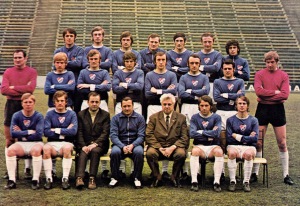 In the decades before blanket television coverage of European football became the norm, little was known about teams from the far-flung outposts of the Eastern Bloc. Fixtures were occasional and exposure was fleeting: usually snatched, crackly European competition highlight packages on midweek Sportsnight crammed in as an afterthought once the darts and boxing had been shown.
In the decades before blanket television coverage of European football became the norm, little was known about teams from the far-flung outposts of the Eastern Bloc. Fixtures were occasional and exposure was fleeting: usually snatched, crackly European competition highlight packages on midweek Sportsnight crammed in as an afterthought once the darts and boxing had been shown.
So the provincial Georgians of Dinamo Tbilisi represented a mysterious and exotic bolt from the blue with their extraordinary football operating on a level way beyond anything I had encountered. Who are these players and what planet did they come from? Had you told a young me that these men were footballing aliens brought to earth by Soviet Cosmonauts on a mission to conquer the world game, I might just have believed you.
It was a First Round tie against Liverpool in the 1979-80 European Cup that introduced Tbilisi to a startled British public. Being drawn against the recent two-time winners looked the most daunting of European Cup debuts for the Georgian club, but at no stage of this tie did they look remotely cowed by their heavyweight opponents. Only finishing that fell short of their otherwise lofty levels of technical play allowed Liverpool to edge the Anfield leg 2-1. Tbilisi’s first leg promise was fully realised in the return as they eased to a 3-0 victory in a packed Boris Paichadze National Stadium.
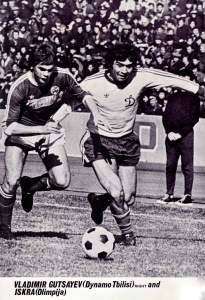 The performance that afternoon was resoundingly accomplished. The South American levels of skill that many of their players possessed operated harmoniously within the traditional Soviet framework of selflessness and team-orientated passing. The first two goals were thrilling: Alan Hansen was left looking foolish after being deceived by a brilliant piece of Kipiani trickery in the penalty box and the veteran set up Gutsaev for the opener. The second saw defender Georgi Chilaya charge 60 yards upfield from left back then neatly set up Shengalia to cutely chip Ray Clemence inside the box. Older Liverpool fans might have appreciated the symmetry between Chilaya’s surge and a similar one by Facchetti for Inter at the San Siro in a European Cup tie fifteen years early. Liverpool’s players looked baffled, battered and bemused. The Anfield side experienced losses during their 1977-85 European Cup era, but this was one of the very few occasions when they were simply outclassed.
The performance that afternoon was resoundingly accomplished. The South American levels of skill that many of their players possessed operated harmoniously within the traditional Soviet framework of selflessness and team-orientated passing. The first two goals were thrilling: Alan Hansen was left looking foolish after being deceived by a brilliant piece of Kipiani trickery in the penalty box and the veteran set up Gutsaev for the opener. The second saw defender Georgi Chilaya charge 60 yards upfield from left back then neatly set up Shengalia to cutely chip Ray Clemence inside the box. Older Liverpool fans might have appreciated the symmetry between Chilaya’s surge and a similar one by Facchetti for Inter at the San Siro in a European Cup tie fifteen years early. Liverpool’s players looked baffled, battered and bemused. The Anfield side experienced losses during their 1977-85 European Cup era, but this was one of the very few occasions when they were simply outclassed.
Tbilisi’s next English encounter was a 1981 Cup Winners Cup Quarter Final tie against West Ham. The first leg at the Boleyn Ground turned into a masterclass of intelligent, flexible and incisive football by the visitors who demonstrated some of the best counter-attacking football you’re likely to see in your lifetime. Footage from this match should be included as part of the learning materials for UEFA coaching courses.
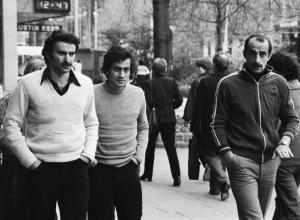 West Ham spent much of the evening forlornly chasing slippery white shadows and could consider themselves rather fortunate to escape with just a 4-1 home defeat. The opening Tbilisi goal was so ridiculously good that it belonged more in a Roy of the Rovers cartoon than on a football pitch. After a succession of slick passes, Aleksandre Chivadze collected a knockdown ten yards inside his own half, surged forward into West Ham territory and let fly from 30 yards with a dipping drive that sailed over the head of a flat-footed Phil Parkes. That’s Aleksandre Chivadze the defender by the way, admittedly a defender who had greater mastery of the ball than any creative outfield British player I had seen.
West Ham spent much of the evening forlornly chasing slippery white shadows and could consider themselves rather fortunate to escape with just a 4-1 home defeat. The opening Tbilisi goal was so ridiculously good that it belonged more in a Roy of the Rovers cartoon than on a football pitch. After a succession of slick passes, Aleksandre Chivadze collected a knockdown ten yards inside his own half, surged forward into West Ham territory and let fly from 30 yards with a dipping drive that sailed over the head of a flat-footed Phil Parkes. That’s Aleksandre Chivadze the defender by the way, admittedly a defender who had greater mastery of the ball than any creative outfield British player I had seen.
It was a revelation to watch a player from the back line who caressed the ball around a pitch rather than just blooter it. Chivadze just didn’t look like he originated from the same species, never mind play in the same position as the cumbersome central defensive threshing machines I was used to watching. It was a similar story throughout the team: the quick clever feet of David Kipiani so adept at unbalancing opponents; Ramas Shengelia’s strength and seemingly telepathic awareness of his colleagues’ runs; Vladimir Gutsayev’s finely tuned radar for goal and emphatic, calm finishing and the nimble, scuttling style of Vitali Daraselia, always cleverly finding pockets of space to work in.
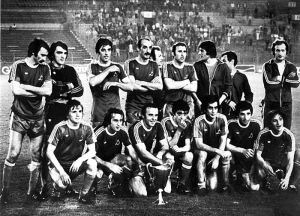 This was an exhibition of the giddy heights of beauty that football could reach and set a demanding benchmark I would judge all subsequent teams against. Here was a side that from front to back was so focused, so comfortable in possession, so assured in their touch, so adept with their flicks and feints and so clever at manufacturing passing angles.
This was an exhibition of the giddy heights of beauty that football could reach and set a demanding benchmark I would judge all subsequent teams against. Here was a side that from front to back was so focused, so comfortable in possession, so assured in their touch, so adept with their flicks and feints and so clever at manufacturing passing angles.
For teams to have pace in abundance was assumed, then as now, to be a great asset and yet this Tbilisi side appeared to have a mastery of the more complex dynamics underpinning tempo. The Georgians understood the notion that opponents were much more disoriented by change of pace rather than just outright pace in itself. Tempo was there to be manipulated: to slow the game down to a crawl before exploding into life and tearing into surprised opponents who could not just flick a switch and adapt to the quicker game being imposed upon them. West Ham’s players could do little more than wander around the pitch in a shell-shocked state, hoping more by chance than intention to get in the way of the deft passing patterns of these Soviet supermen.
Having spilled hundreds of words in praise of this Tbilisi team, incongruously I’ll now have to admit that the nature of this recollection could probably only have originated from someone of British provenance. There was just something about this team that seemed to reserve its very best performances for games against English opposition – which were the only games I saw them play of course.
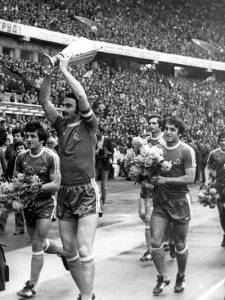 Dinamo’s broader record in European competition during these years is surprisingly unremarkable and my view might not be so rose-tinted if, for example, I had been able to watch highlights of them being smacked 4-0 by Grasshoppers Zurich in the 1977-78 UEFA Cup. And then there were the undistinguished European exits to Hertha Berlin, Hamburg and Standard Liege. Even that team’s greatest moment, the 1981 Cup Winners Cup win, came after a dour Final against modest Carl Zeiss Jena that was a rather harder fought game than it should have been.
Dinamo’s broader record in European competition during these years is surprisingly unremarkable and my view might not be so rose-tinted if, for example, I had been able to watch highlights of them being smacked 4-0 by Grasshoppers Zurich in the 1977-78 UEFA Cup. And then there were the undistinguished European exits to Hertha Berlin, Hamburg and Standard Liege. Even that team’s greatest moment, the 1981 Cup Winners Cup win, came after a dour Final against modest Carl Zeiss Jena that was a rather harder fought game than it should have been.
So perhaps had I been German, Swiss or Belgian, my enduring impression of that Dinamo Tbilisi team might have been more centred on their flaws, like the lack of command in the air defensively or the unreliable keeper, Gabelia, who was prone to avoidable error after avoidable error. It’s all hypothetical of course and even the passage of time has failed to dull those first childhood impressions and my unshakeable belief that, between 1978 and 1981, Dinamo Tbilisi was the closest team my generation had to total football-era Ajax.
We’ve collated some of the best Dinamo Tbilisi footage from the era and you can view them by clicking on the Dinamo Tbilisi On Film link or the image below.


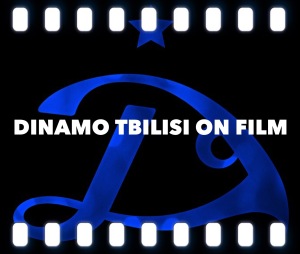

This is Banik Ostrava.